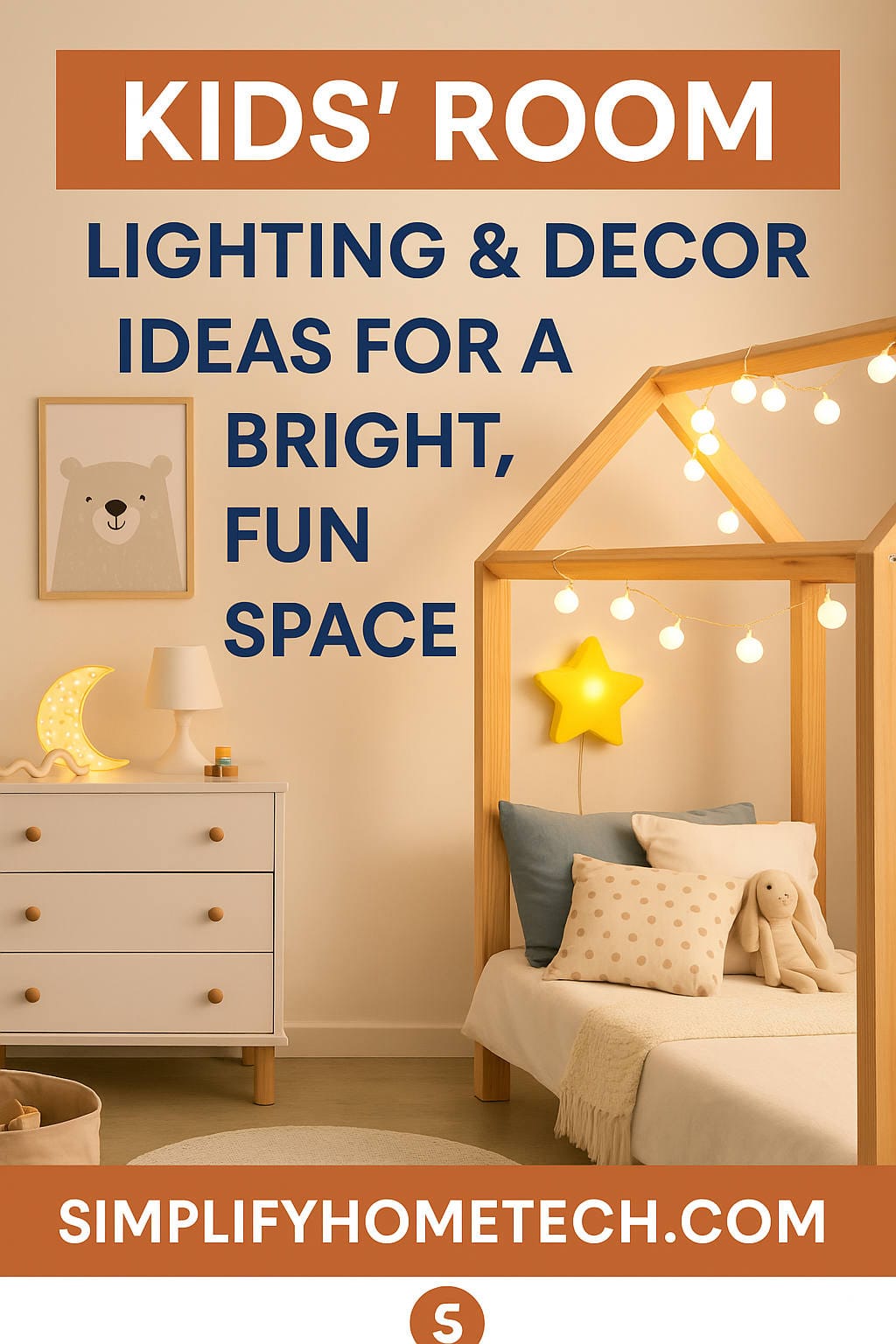Designing a child’s room is an exciting journey that combines creativity, functionality, and care. As your child grows, their room must adapt to meet their changing needs—from a cozy space to sleep and relax to a stimulating environment that encourages play and learning. Among the many elements that contribute to a well-designed kids’ room, lighting is often overlooked but plays a foundational role in shaping how the space is used and experienced.
In this comprehensive guide, we’ll explore how to create a balanced and beautiful lighting plan tailored to a child’s needs. You’ll discover expert tips, age-specific advice, and creative decor ideas that can turn any room into a magical haven for your little one.
Why Lighting Is a Game-Changer in Kids’ Rooms
Children spend a large portion of their time in their rooms, whether it’s for resting, playing, learning, or exploring. Thoughtful lighting enhances their experience, supporting everything from emotional well-being to visual comfort and safety.
Proper lighting in a child’s room helps with:
- Creating a sense of comfort and security
- Promoting better sleep hygiene
- Enhancing focus during homework or reading
- Reducing strain on young eyes
- Safeguarding nighttime movement
By integrating different lighting layers and matching them with smart decor, you can transform a simple room into a nurturing and dynamic environment.
The Power of Layered Lighting: Building a Flexible Space
Layered lighting refers to the combination of different light sources to serve various functions. For a child’s room, this technique provides the versatility to accommodate multiple activities while creating ambiance.
1. Ambient Lighting
Ambient lighting forms the room’s general illumination. This is usually provided by ceiling lights such as flush mounts, semi-flush fixtures, or modern chandeliers.
Pro Tip: Choose fixtures with diffusers to eliminate harsh shadows and opt for warm white LED bulbs (2700K–3000K) for a soothing glow.
2. Task Lighting
Designed to brighten specific areas, task lighting is essential for activities like reading, drawing, or studying. Desk lamps with adjustable arms and clip-on lights are ideal.
Pro Tip: Look for LED lamps with adjustable brightness and color temperatures to accommodate different times of day and reduce eye fatigue.
3. Accent and Decorative Lighting
Accent lighting adds flair and personality. Think string lights, wall sconces, or lamps in fun shapes.
Pro Tip: Use dimmable accent lights to create a relaxed bedtime ambiance or energize the room during playtime.
Nightlights: Providing Comfort After Dark
Nightlights are a staple in many children’s rooms, offering reassurance and gentle light for late-night trips to the bathroom or to soothe nighttime fears.
Popular Nightlight Types:
- Plug-in lights with dusk-to-dawn sensors
- Projector nightlights that cast stars or animals on the ceiling
- Rechargeable silicone nightlights in the form of bunnies, bears, or dinosaurs
Safety Checklist:
- Choose cool-touch LED models
- Keep all cords out of reach
- Look for automatic shut-off features to preserve battery life and promote sleep
Creative and Thematic Lighting Ideas
Lighting can do more than illuminate—it can tell a story, spark imagination, and personalize your child’s space. Get creative with fixtures and bulbs that align with your child’s interests.
Fun Ideas to Try:
- Pendant lights shaped like rockets, clouds, or hot air balloons
- Twinkling string lights woven into a bed canopy
- Neon LED signs spelling their name or a favorite word
- Smart bulbs that shift colors to suit the mood or time of day
Bonus: Use removable wall decals or peel-and-stick LED tape lighting to match evolving tastes without a permanent commitment.
Natural Light: The Free Mood Booster
Sunlight is a natural and effective way to brighten up any room. Beyond boosting mood and regulating circadian rhythms, it helps reduce the reliance on artificial lighting during the day.
Tips to Maximize Natural Light:
- Use sheer curtains to filter light without making the room too dark
- Position reading or study areas near windows
- Keep window sills clear of clutter or heavy furnishings
- Paint walls in light, reflective tones such as soft beige, pastel blue, or warm white
Choosing Fixtures That Are Stylish and Safe
In a child’s room, lighting fixtures need to be as safe as they are stylish. Here are some best practices for choosing and installing lighting:
- Flush or semi-flush ceiling lights prevent kids from pulling on or bumping into hanging parts
- Cordless or battery-operated lamps reduce electrical hazards
- Wall-mounted sconces are excellent for bedtime reading without occupying surface space
- Shatterproof bulbs and casings enhance durability and safety
Installation Tip: Secure all fixtures tightly and position them out of children’s reach whenever possible.
Integrating Lighting with Decor: Harmonizing Form and Function
Great lighting can become a key part of the room’s overall design aesthetic. Matching decor elements with your lighting choices adds depth and cohesion to the space.
1. Use Color Psychology
Choose hues that support the room’s intended function:
- Cool tones like blue and green promote calmness in sleeping zones
- Warm tones like yellow or coral add energy to play areas
2. Create Focal Zones
Divide the room into distinct functional areas:
- Reading nook: Add a cozy armchair, a canopy, and a floor or wall-mounted reading lamp
- Study zone: Include a clutter-free desk, ergonomic chair, and an adjustable LED desk lamp
- Play corner: Use overhead lights or a large floor lamp paired with fun, glowing shapes
3. Wall Features
Frame wall art, murals, or bulletin boards with fairy lights or mini-spotlights to give them extra visual appeal.
4. Textiles and Accessories
Pair lighting with themed bedding, area rugs, and throw pillows for a coordinated look. Choose washable materials for easy maintenance.
Age-Appropriate Lighting and Decor Strategies
Children’s preferences and routines shift with age, so it’s important to keep your lighting plan flexible.
Infants and Toddlers (0–3 years)
- Install dimmable overhead lighting and a soft nightlight
- Use blackout curtains to encourage longer naps
- Avoid floor lamps or cords that toddlers might pull on
Preschoolers (3–6 years)
- Add creative lighting such as star projectors or string lights
- Use themed decor to encourage imaginative play
- Include easy-to-operate lighting switches or touch lamps
Early School Age (6–9 years)
- Provide bright task lighting for drawing and homework
- Use wall-mounted fixtures to save space on desks or nightstands
- Consider color-changing bulbs to make routines fun (e.g., red for bedtime, blue for homework)
Tweens and Teens (10–18 years)
- Opt for modern lighting styles like LED strips or industrial desk lamps
- Introduce smart bulbs with app or voice control
- Let them customize their space with statement pieces like neon wall lights
Embracing Smart Lighting: Tech That Grows with Your Child
Smart lighting systems are a fantastic investment for modern families. They bring both fun and functionality to a child’s room while teaching responsibility and routine.
Key Features to Look For:
- Voice control via Alexa, Google Home, or Siri
- Scheduling capabilities to automate bedtime and wake-up times
- App control for brightness and color changes
- Motion sensors for safe nighttime navigation
Parental Benefits:
- Set bedtime dimming routines remotely
- Turn off forgotten lights from your smartphone
- Use geofencing to ensure lights turn off when no one is home
Safety Considerations for Kids’ Room Lighting
Safety should always come first when it comes to designing children’s spaces. Here’s how to light their room with peace of mind:
- Avoid glass fixtures and choose impact-resistant materials
- Keep cords tidy with cord organizers or tubing
- Position lamps away from beds, cribs, or climbing zones
- Use tamper-proof outlet covers
- Choose certified low-heat LED bulbs
Regularly inspect fixtures and replace any broken or frayed components promptly.
Storage Meets Illumination: Tidy, Bright, and Efficient
Storage and lighting can work together for added convenience and charm. Brightening storage spaces helps children see and access their belongings easily.
Ideas to Combine Storage and Lighting:
- Install LED strips under shelves and inside closets
- Use labeled bins with glow-in-the-dark labels
- Add motion sensor lights to toy chests or under-bed drawers
- Try multi-functional furniture like ottomans with interior lighting
This makes cleanup easier and encourages responsibility in younger children.
Final Thoughts: Creating a Room That Grows with Your Child
Lighting and decor are powerful tools in shaping your child’s environment. With thoughtful design, their room can inspire creativity, support development, and offer a cozy escape.
Let’s recap the essentials:
- Combine ambient, task, and accent lighting for flexibility
- Choose safe, durable fixtures with child-friendly designs
- Maximize natural light and use soft, warm tones to promote relaxation
- Decorate with intention, creating zones for sleep, play, and study
- Embrace smart tech to future-proof the room
- Keep everything safe, accessible, and adaptable
Above all, make it fun! Involve your child in picking colors, shapes, or themed lighting that reflects their personality. With the right mix of form and function, their room will become a beloved space for years to come.
Need more inspiration? Explore our smart lighting picks and decor ideas for every stage of childhood.
You might also like,

